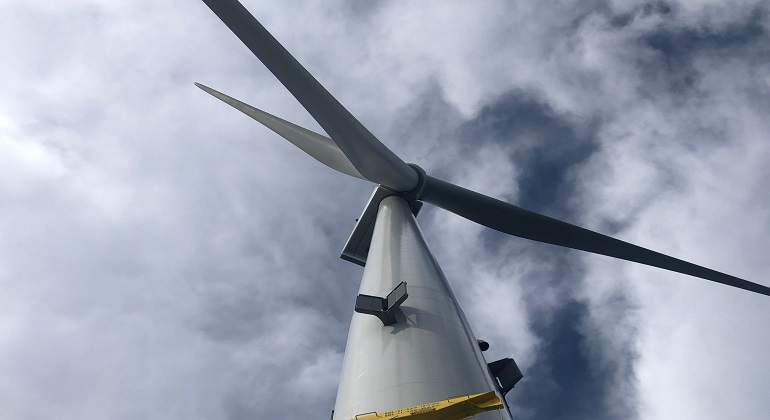After successfully completing the first year of the commissioning of the world’s first semi-submersible floating wind farm, located off the coast of Viana do Castelo (Portugal), EDP Renovables focuses on Spain for its next projects. “It is a country with enthusiasm for off-shore and with the ideal conditions for this type of technology,” José Pinheiro, project director, explained on Thursday.
Windfloat Atlantic, the name given to this ambitious offshore wind plan from a consortium led by a joint venture of EDP and Engie (Ocean Winds) and which also includes Repsol and Principle Power Incen, generated a total of 75 gigawatt hours (GWh ) in its first year of operation. In other words, it produced enough energy to supply 60,000 inhabitants and prevent the emission of 33,000 tons of CO2 into the atmosphere .
The system used allows the wind turbines to be installed in waters more than 50 meters deep, making it possible to locate these infrastructures in previously unviable territories, such as the coasts of the north of the peninsula or the Canary Islands . In fact, there are already concrete plans to move forward with a floating park in the Canary Islands, as recently Ocean Winds and the Spanish group Disa announced a collaboration for this project, which could create up to 3,700 direct and indirect jobs.
The Portuguese floating wind farm is 18 kilometers off the coast of Viana do Castelo and consists of three turbines mounted on floating platforms moored to the seabed with a total installed capacity of 25 MW, 8.4 MW each. This structure is anchored in waters up to 100 meters deep, in an area of sand and sediments suitable for mooring, and has the capacity to withstand waves of 20 meters and winds of up to 100 km / h.
Although the project became fully operational in July 2020, it has been underway for several years. And it is that a decade ago, in December 2011, the WindFloat 1 pilot project was launched, on the coast of Póvoa de Varzim, Portugal. This was the first offshore wind deployment in the world, without resorting to the traditional piles used in this type of infrastructure. “WindFloat 1 remained in operation for five years with a very high availability, producing more than 17 GWh in the high seas with waves of more than 7 meters and without suffering from waves of up to 17 meters”, they explain from EDP. The person in charge of directing the project was EDP Innovation.
In order to support the development of this pioneering technology, the European Investment Bank (EIB) granted in October 2018 a loan of 60 million euros to Windplus, the company that develops the WindFloat Atlantic project and is owned by Ocean Winds. (54.4%), a joint venture between EDP Renováveis and Engie, Repsol (19.4%) and Principle Power (1.2%). The project was also supported with 29.9 million euros from the EU NER300 program, six million euros from the Government of Portugal through the Portuguese Carbon Fund, in addition to funds from Windplus shareholders.
The installation of the first turbine of the WindFloat Atlantic project was carried out in July 2019, in the Galician port of Ferrol , in Spain, and constituted an important milestone for the WindFloat Atlantic project and the offshore wind energy sector worldwide. as it is the largest turbine ever installed on a floating platform. The other two turbines were manufactured in the shipyards of Setúbal (Portugal).
Both the construction and the assembly were carried out on land, avoiding the environmental impact, and special vessels were not used, since the structures were towed with traditional boats. A consortium of companies with complementary activities was in charge of developing and building the project.
In addition to Portugal, with the Windfloat Atlantic project, Ocean Winds has been present since its inception in seven countries, where it will continue to develop current projects: on the west and east coast of the United States – with the California projects (100-150 MW ) and Mayflower (1,300 MW) -, in the United Kingdom -Moray East (950 MW) and Moray West (800-860 MW) -, in Belgium -SeaMade (487 MW), in France -Leucate (30 MW) and Tréport & Noirmoutier (992 MW) – in Poland -B & C Wind (400 MW) – and in South Korea -Korea Floating Wind (3×500 MW) -. As José Pinheiro pointed out, Spain, as well as Greece, Portugal and France stand out among the countries of interest for the development of future projects .


